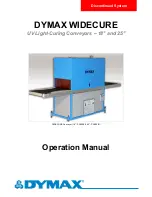
Dymax WIDECURE UV Conveyor
4
SAFETY
CAUTION!
Always wear protective goggles or face shield when working near the front of the unit,
which emits UV light! The rear of the unit also emits stray UV light.
WARNING!
Always observe safety requirements!
CAUTION!
This unit generates ozone during operation. Adequate ventilation should be provided
or the unit should exhaust to outside.
CAUTION!
Risk of electrical shock if controller cover is removed!
CAUTION!
The sides of the unit are warm to the touch when unit is in operation!
To maximize safety, equipment should be set up properly with components correctly connected and operated in
accordance with relevant instructions. This light-curing system was developed to maximize operator safety and
minimize exposure to UV.
SAFETY RECOMMENDATIONS:
•
Use goggles or a face shield approved for complete UV protection to protect your eyes.
•
Long-sleeved shirts or a lab coat are recommended to protect the arms and the use of UV-opaque gloves
to protect the hands.
DYMAX UV LIGHT-CURING SYSTEM SAFETY CONSIDERATIONS
Dymax ultraviolet light-curing technology has been used successfully for over 30 years. The fast cure, one-
component nature of our UV light-curing technology has made it the process of choice for many manufacturers
requiring a cure on demand assembly process. There are four common questions/concerns related to UV light-
curing systems: UV exposure, high-temperature surfaces, ozone, and bright, visible light.
UV EXPOSURE
Standard Dymax UV light-curing systems and bulbs have been designed to primarily emit UVA light
(as shown in
Chart 1). UVA light is generally considered the safest of the three UV ranges: UVA, UVB, and UVC. Although
OSHA does not currently regulate ultraviolet light exposure in the workplace, the American Conference of
Governmental Industrial Hygienists (ACGIH) does recommend Threshold Limit Values (TLV
s) for ultraviolet light.
The strictest interpretation of the TLV (over the UVA range) for workers’ eyes and skin is 1 mW/cm
2
(intensity),
continuous exposure. Unless workers are placing bare hands into the curing area, it is unusual to exceed these
limits. To put 1 mW/cm
2
limit into perspective, cloudless summer days in Connecticut regularly exceed 3 mW/cm
2
of UVA light and also include the more dangerous UVB light (primarily responsible for sun tans, sun burns, and
skin cancer) as well.
The human eye can not detect UV energy, only visible light. A radiometer should be used to measure stray UV
energy to confirm the safety of a UV light-curing process. A workstation that exposes an operator to more than
1 mW/cm
2
of UVA energy continuously should be redesigned.
Curing of UV light-curable chemistry
can be a regulatory compliant, “worker-friendly” manufacturing process when
the proper safety equipment and operator training is utilized. There are two ways to protect operators from UV
exposure: shield the operator and/or shield the source.


































